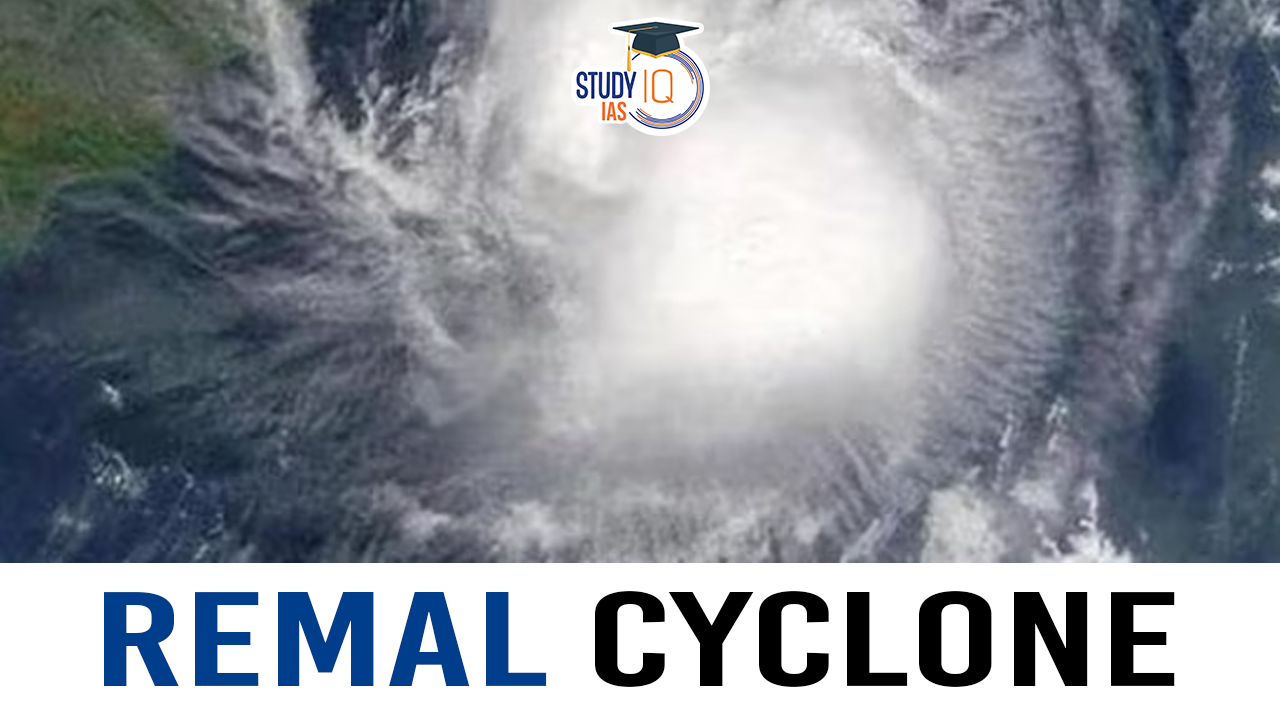Table of Contents
Cyclone Remal killed 4 people in West Bengal as post-Remal rain continues and nearly 29,500 houses were damaged and 77,200 people still in camps. Cyclonic Remal originated in the central Bay of Bengal and intensified into a severe cyclonic storm with the India Meteorological Department predicting landfall between Sagar Island (West Bengal) and Khepupara (Bangladesh) with wind speeds of 110-120 kmph, gusting to 135 kmph. Check Out Cyclone Remal Live Update in this article.
Latest Updates on Cyclone Remal
Cyclone Remal Landfall
- Cyclone Remal made landfall at 8:30 PM on Sunday, impacting the coastal regions between Sagar Island in West Bengal and Khepupara in Bangladesh, southwest of Mongla.
- The cyclone caused significant damage and disruption, leading to the evacuation of nearly a million people over the past two days.
Impact on Kolkata
- Kolkata experienced heavy rain and strong winds following the cyclone’s landfall.
- Teams from the Kolkata Municipality and Kolkata Police Disaster Management are working to clear uprooted trees, particularly in the Alipore area.
- Deputy Commissioner of South Kolkata, Priyabrata Roy, informed ANI that efforts are ongoing to clear roads of debris, with the situation expected to improve by morning. Unified control rooms are monitoring the situation throughout the night.
Weather Conditions
- Coastal Bengal experienced gale-force winds of 100-110 kmph on Sunday evening, with similar effects felt in North Odisha.
- Howrah, Hooghly, Kolkata, and East Medinipur witnessed winds of 45-55 kmph, with gusts up to 65 kmph, expected to intensify to 70-80 kmph, gusting to 90 kmph.
Evacuation and Relief Efforts
- The West Bengal government relocated approximately 110,000 people from coastal areas, including the Sundarbans and Sagar Island, to cyclone shelters.
- The National Disaster Response Force (NDRF) deployed 14 teams across nine districts, with additional teams on standby.
Government Response
- Prime Minister Narendra Modi received updates on the situation, with the National Crisis Management Committee maintaining regular contact with the West Bengal government.
- He directed that, in addition to the 12 NDRF teams already in West Bengal and one in Odisha, more teams should be on standby for rapid deployment. The Indian Coast Guard is also prepared for emergencies.
- The Prime Minister instructed that Ports, Railways, and Highways remain on high alert to prevent incidents.
State Preparations
- West Bengal Governor Ananda Bose held an emergency review meeting on Cyclone Remal.
- In Tripura, Chief Minister Manik Saha assured that the state and district administrations are fully prepared to handle the cyclone’s impact, urging residents to exercise utmost caution.
- A red alert was issued for four districts in Tripura: South, Dhalai, Khowai, and West, in response to the severe cyclonic storm.
About Cyclone Remal
| Important facts about Cyclone Remal | |
| Name Origin | The name ‘Remal’ for the tropical cyclone was given by Oman. This follows the international protocol for naming tropical cyclones in the Indian Ocean region. |
| Meaning of Remal | ‘Remal’ means ‘sand’ in Arabic. |
| First Cyclone | It is the first cyclone to hit the region in the 2024 pre-monsoon season, highlighting the importance of early preparedness and monitoring. |
| Origin | Cyclone Remal originated in the Bay of Bengal (BoB). |
Cyclone Remal: Features
Landfall and Wind Speed:
- The India Meteorological Department (IMD) predicts landfall around midnight on Sunday.
- Wind speeds are expected to be highest in South and North 24 Parganas districts, reaching 110-120 kmph.
Rainfall:
- Red Alert: Issued for the coastal districts of South and North 24 Parganas, expecting extremely heavy rainfall along with strong winds.
- Orange Alert: Issued for Kolkata, Howrah, and Purba Medinipur districts, with heavy to very heavy rainfall and wind speeds of 80-90 kmph.
- Light to moderate rainfall: Likely to begin on Saturday and intensify through Sunday and Monday.
Affected Areas:
- Coastal districts of West Bengal, particularly South and North 24 Parganas.
- Northern Odisha is likely to experience isolated heavy rainfall and wind speeds of 40-50 kmph.
- Other northeastern states like Mizoram, Manipur, Nagaland, Tripura, and Assam might also see strong winds and increased rainfall.
Contributing Factors for Formation of Cyclone Remal
- Depression Formation: The genesis of Cyclone Remal began with the formation of a depression over the central Bay of Bengal. This area of low pressure is characterized by circulating winds and atmospheric instability.
- Sea Surface Temperatures: The Bay of Bengal is experiencing water temperatures that are 2–3°C higher than average, providing the necessary energy for cyclonic development.
- Madden Julian Oscillation (MJO): The MJO, an eastward-moving band of clouds and winds, is currently positioned south of the Bay of Bengal. This enhances the cyclonic activity by contributing to atmospheric instability and rotational wind patterns.
Cyclone Remal: Areas on Alert
The IMD has issued several alerts for different regions based on the expected severity of the cyclone:
West Bengal
- South and North 24 Parganas: A red alert has been issued with expected wind speeds of 100 to 110 km/h on May 26 and 90 to 100 km/h on May 27, accompanied by extremely heavy rainfall.
- Kolkata, Howrah, Purba Medinipur: An orange alert is in place with wind speeds of 80 to 90 km/h on May 26 and 70 to 80 km/h on May 27, along with heavy to very heavy rainfall.
- Paschim Medinipur, Purba Bardhaman, Nadia: These districts are expected to experience significant rainfall on May 26 and 27.
Odisha
- Balasore, Bhadrak, Kendrapara: A yellow warning indicates heavy to very heavy rainfall (7 to 20 cm) on May 26. Rain is also likely to affect these areas on May 27.
Cyclone Remal Potential Impact
- Sundarbans Region: The fragile ecosystem of the Sundarbans could suffer partial damage if the cyclone coincides with high tide, leading to severe flooding and storm surges.
- Storm Surges and Flooding: The shallow bathymetry and funnel-shaped geography of the northern Bay of Bengal can amplify the cyclone’s intensity, increasing the risk of extensive storm surges and flooding.
Preparedness Measures for Cyclone Remal
A comprehensive set of preparedness measures has been activated to mitigate the impact of Cyclone Remal:
Government and Agencies
- National Disaster Response Force (NDRF): 12 teams have been deployed with 5 additional teams on standby.
- Army, Navy, and Coast Guard: Rescue and relief teams, along with ships and aircraft, are ready for immediate deployment.
- Shipping Alerts: Regular alerts and advisories are being issued to the ports of Kolkata and Paradip.
- Power Restoration: Emergency teams are prepared for rapid restoration of power supplies in affected areas.
Local Authorities
- District Control Rooms: Activated control rooms are ensuring the availability of adequate shelters, power supplies, medicines, and emergency services.
- Evacuation and Safety: Residents in vulnerable areas have been advised to evacuate to safer locations and to remain indoors during the cyclone’s passage.
Comparative Analysis: Bay of Bengal vs. Arabian Sea
- Cyclone Frequency: The Bay of Bengal traditionally experiences more cyclones than the Arabian Sea, with a ratio of about 4:1. However, recent studies indicate an increasing frequency of cyclones in the Arabian Sea due to changing climate patterns.
- Geophysical Differences: The Bay of Bengal’s relatively shallow depth and larger surface area result in faster heating and higher evaporation rates, making it more conducive to cyclone formation.
- Climate Change Impact: The positive phase of the Indian Ocean Dipole (IOD) and human-induced climate change are contributing to the increasing frequency and severity of cyclones in both the Bay of Bengal and the Arabian Sea.
| Previous Cyclones |
|
| Council on Energy, Environment and Water (CEEW) Study Findings |
|
| About National Cyclone Risk Mitigation Project (NCRMP) |
|
Cyclone Remal UPSC
Cyclone Remal is a significant weather event with the potential to cause extensive damage to the coastal regions of West Bengal and Bangladesh. With robust preparedness measures in place, authorities aim to minimize the cyclone’s impact and ensure the safety of all residents. Continuous monitoring and timely updates will be crucial in managing the situation as Cyclone Remal approaches landfall. Stay tuned for further updates and follow all advisories from the IMD and local authorities to stay safe.
| Other Important Articles | |
| Cyclone Michaung | Formation of Cyclones |
| Cyclone Biparjoy |
How Cyclones Affect Monsoon Onset |


 SSC MTS Salary 2025, Check Highest Salar...
SSC MTS Salary 2025, Check Highest Salar...
 F-35 Fighter Jet Stranded in Kerala: Dis...
F-35 Fighter Jet Stranded in Kerala: Dis...
 Quad Summit 2025: Key Announcements, Str...
Quad Summit 2025: Key Announcements, Str...





















